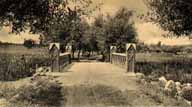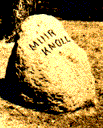

 |
 |
|
Nevertheless, I still indulged my love of mechanical inventions. I invented a desk in which the books I had to study were arranged in order at the beginning of each term. I also made a bed which set me on my feet every morning at the hour determined on, and in dark winter mornings just as the bed set me on the floor it lighted a lamp. Then, after the minutes allowed for dressing had elapsed, a click was heard and the first book to be studied was pushed up from a rack below the top of the desk, thrown open, and allowed to remain there the number of minutes required. Then the machinery closed the book and allowed it to drop back into its stall, then moved the rack forward and threw up the next in order, and so on, all the day being divided according to the times of recitation, and time required and allotted to each study. Besides this, I thought it would be a fine thing in the summer-time when the sun rose early, to dispense with the clock-controlled bed machinery, and make use of sunbeams instead. This I did simply by taking a lens out of my small spy-glass, fixing it on a frame on the sill of my bedroom window, and pointing it to the sunrise; the sunbeams focused on a thread burned it through, allowing the bed machinery to put me on my feet. When I wished to arise at any given time after sunrise, I had only to turn the pivoted frame that held the lens the requisite number of degrees or minutes. Thus I took Emerson's advice and hitched my dumping-wagon bed to a star. I also invented a machine to make visible the growth of plants and the action of the sunlight, a very delicate contrivance, enclosed in glass. Besides this I invented a barometer and a lot of novel scientific apparatus. My room was regarded as a sort of show place by the professors, who oftentimes brought visitors to it on Saturdays and holidays. And when, some eighteen years after I had left the University, I was sauntering over the campus in time of vacation, and spoke to a man who seemed to be taking some charge of the grounds, he informed me that he was the janitor; and when I inquired what had become of Pat, the janitor in my time, and a favorite with the students, he replied that Pat was still alive and well, but now too old to do much work. And when I pointed to the dormitory room that I long ago occupied, he said: "Oh then I know who you are," and mentioned my name. "How comes it that you know my name?" I inquired. He explained that "Pat always pointed out that room to newcomers and told long stories about the wonders that used to be in it." So long had the memory of my little inventions survived. Although I was four years at the University, I did not take the regular course of studies, but instead picked out what I thought would be most useful to me, particularly chemistry, which opened a new world, and mathematics and physics, a little Greek and Latin, botany and geology. I was far from satisfied with what I had learned, and should have stayed longer. Anyhow I wandered away on a glorious botanical and geological excursion, which has lasted nearly fifty years and is not yet completed, always happy and free, poor and rich, without thought of a diploma or of making a name, urged on and on through endless, inspiring, Godful beauty. From the top of a hill on the north side of Lake Mendota I gained a last wistful, lingering view of the beautiful University grounds and buildings where I had spent so many hungry and happy and hopeful days. There with streaming eyes I bade my blessed Alma Mater farewell. But I was only leaving one University for another, the Wisconsin University for the University of the Wilderness. |
||
 |
University Drive, Madison
Wisconsin |
 |
Muir, John. The Story of My Boyhood and Youth. Boston and
New York: Houghton Mifflin, 1917.
From the UW Madison Memorial Library: Y M896 /1